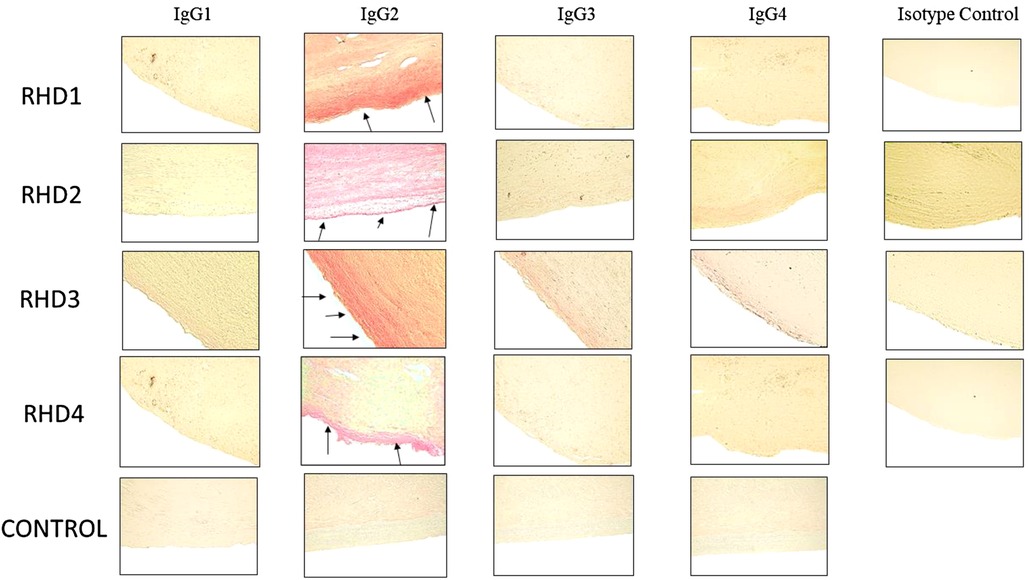IgG2 rules: N-acetyl-β-D-glucosamine-specific IgG2 and Th17/Th1 cooperation may promote the pathogenesis of acute rheumatic heart disease and be a biomarker of the autoimmune sequelae of Streptococcus pyogenes
- 1Department of Biological Sciences, California State University, Sacramento, CA, United States
- 2Department of Health and Human Services, Pediatrics and Developmental Neuropsychiatry Branch, National Institute of Mental Health, National Institutes of Health, Bethesda, MD, United States
- 3Departments of Pediatrics, Infectious Diseases, Cardiology, and Pathology, University of Utah College of Medicine, Salt Lake City, UT, United States
- 4Division of Cardiology, University of Witwatersrand, Johannesburg, South Africa
- 5Department of Comparative Medicine, University of Oklahoma Health Sciences Center, Oklahoma City, OK, United States
- 6Department of Pediatrics, Division of Cardiology, University of Oklahoma Health Sciences Center, Oklahoma City, OK, United States
- 7Department of Biostatistics and Epidemiology, University of Oklahoma Health Sciences Center, Oklahoma City, OK, United States
- 8Department of Microbiology and Immunology, University of Oklahoma Health Sciences Center, Oklahoma City, OK, United States
A Corrigendum on
by Kirvan CA, Canini H, Swedo SE, Hill H, Veasy G, Jankelow D, Kosanke S, Ward K, Zhao YD, Alvarez K, Hedrick A and Cunningham MW (2023). Front. Cardiovasc. Med. 10: 919700. doi: 10.3389/fcvm.2022.919700
In the published article, there was an error in Figure 5 as published. One of the original figures was accidentally replicated and the correct figure left out. The corrected Figure 5 and its caption appear below.

Figure 5. Immunohistochemistry for IgG subclasses reveals strong human IgG2 deposition in RHD heart tissues from four different patients compared to other subclasses as seen by Fast Red stain of IgG subclass deposition. Red staining of cells indicates a positive IgG binding (see arrows). RHD 1 IgG2 staining is 4+, RHD 2 IgG2 staining is 3+, RHD 3 IgG2 is 4+, RHD 4 IgG2 staining is 2+. Faint staining IgG3 (RHD 3 0.5+) and IgG4 (RHD 2 1 =, RHD 3 0.5+) staining was present. No visible IgG1 staining was observed for any of the four RHD samples. IgG subclass deposition is absent from Isotype control and non-RHD heart tissue(CONTROL). Magnification 400X.
The authors apologize for this error and state that this does not change the scientific conclusions of the article in any way. The original article has been updated.
Keywords: acute rheumatic fever, Th17 cells, IgG subclass, autoimmunity, group A streptococci
Citation: Kirvan CA, Canini H, Swedo SE, Hill H, Veasy G, Jankelow D, Kosanke S, Ward K, Zhao YD, Alvarez K, Hedrick A and Cunningham MW (2023) Corrigendum: IgG2 rules: N-acetyl-β-D-glucosamine-specific IgG2 and Th17/Th1 cooperation may promote the pathogenesis of acute rheumatic heart disease and be a biomarker of the autoimmune sequelae of Streptococcus pyogenes. Front. Cardiovasc. Med. 10:1267920. doi: 10.3389/fcvm.2023.1267920
Received: 27 July 2023; Accepted: 11 August 2023;
Published: 31 August 2023.
Edited and Reviewed by: Roney Orismar Sampaio, University of São Paulo, Brazil
© 2023 Kirvan, Canini, Swedo, Hill, Veasy, Jankelow, Kosanke, Ward, Zhao, Alvarez, Hedrick and Cunningham. This is an open-access article distributed under the terms of the Creative Commons Attribution License (CC BY). The use, distribution or reproduction in other forums is permitted, provided the original author(s) and the copyright owner(s) are credited and that the original publication in this journal is cited, in accordance with accepted academic practice. No use, distribution or reproduction is permitted which does not comply with these terms.
*Correspondence: Madeleine W. Cunningham bWFkZWxlaW5lLWN1bm5pbmdoYW1Ab3Voc2MuZWR1
†Present addresses: Harry Hill, Associated Regional and University Pathologists (ARUP) Institute for Clinical and Experimental Pathology, Salt Lake City, UT, United States; David Jankelow, Linksfield Clinic, Johannesburg, South Africa; Andria Hedrick, University of Oklahoma Health Sciences Center, College of Pharmacy, Oklahoma City, OK, United States
 Christine A. Kirvan
Christine A. Kirvan Heather Canini1
Heather Canini1 Susan E. Swedo
Susan E. Swedo David Jankelow
David Jankelow Madeleine W. Cunningham
Madeleine W. Cunningham